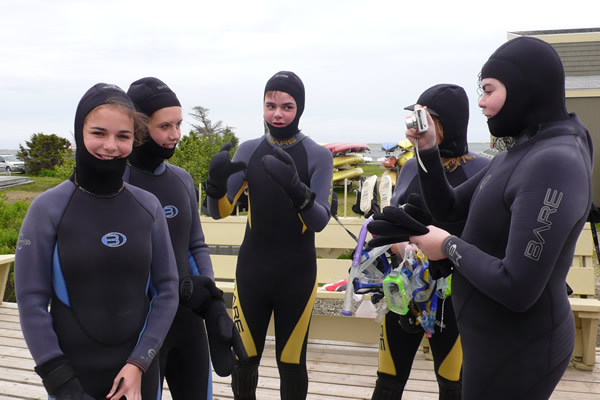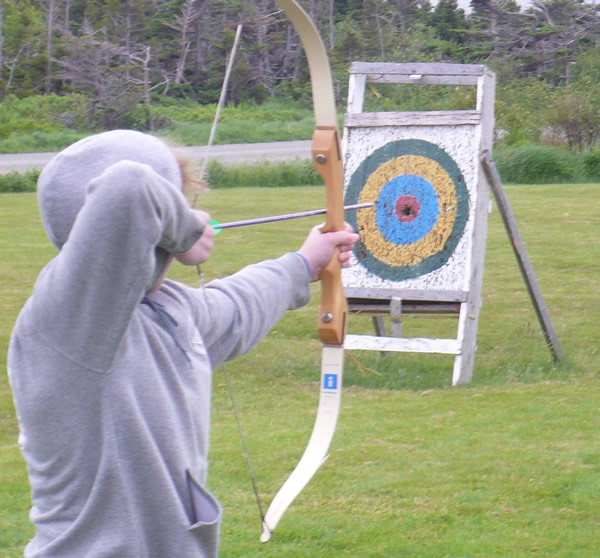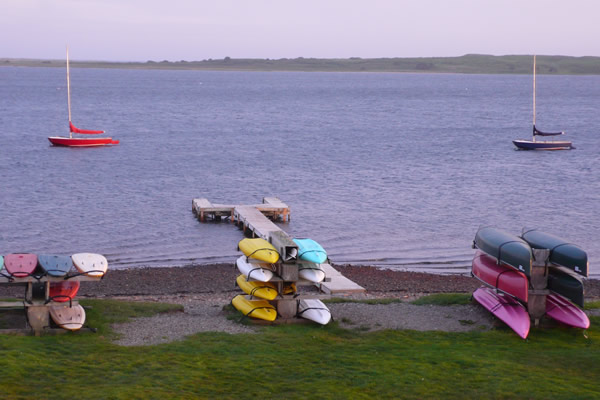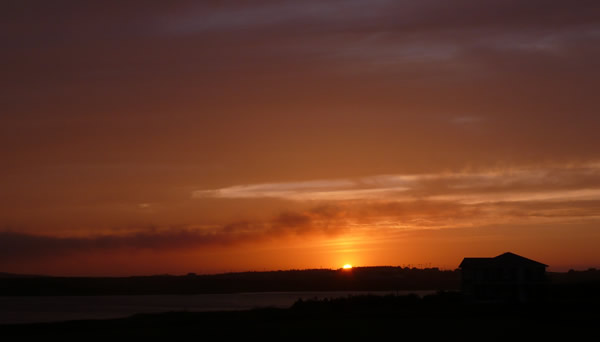French Language Immersion as a Family in Quebec’s Magdalen Islands
Article and photos by Cherie Thiessen

|
|
Students at L’Istorlet — getting ready for some serious snorkeling.
|
The Magdalens
Curling like a fishhook in Canada’s Gulf of St. Lawrence, the Magdalen Islands have always intrigued us, with their remoteness and Acadian history. Over 65 miles from Canada’s Prince Edward Island and 59 miles from Cape Breton, the islands are scarcely known, even in Canada. When a web search turned up a nautical language camp on the archipelago’s most southern island of Havre Aubert, we thought — yes!
Living in British Columbia on Canada’s west coast, my partner, David, and I had rarely had a chance to practice the French we had learned in school. We had often discussed combining a holiday with language immersion; here was our opportunity.
So mid June found us immersing ourselves in the tepid, sheltered waters of the lagoon that fringed the non-profit family nautical camp of L’Istorlet. At the same time we were also submerging ourselves in the beautiful rhythms of the French language as it is spoken in the Magdalen Islands.
The island chain, which stretches only 40 miles, is made up of a dozen islands, six of which are linked by lean, lanky sand dunes propping up a highway. North of Havre Aubert is the commercial hub and busiest island, Cap aux Meules, followed by Havre aux Maisons, tiny Île aux Loups, and the lesser developed Grosse Île and Grande Entrée.
Over 13,000 inhabitants live on this island chain, 95% of them Francophones. Many trace their origins back to the English expulsion of the Acadians from Prince Edward Island, New Brunswick and Nova Scotia back in 1755. These hardy and independent peoples were expelled because they refused to take an oath of allegiance to the British Crown.
The other 5% are Anglophones, also with an interesting history. Many of their descendents were shipwrecked Scottish sailors, rescued from the over 400 ships that met their end on the red, sandstone shores of the Magdalens.
The Camp
With the help of the Magdalen Tourism office we obtained maps and became oriented. We picked up our rental car, heading to L’Istorlet, (French for Arctic Tern) a vacation center started twenty years ago by Rita Castonguay and Alain Arsenault. Once a teacher herself, Rita is actively involved in the camp’s daily activities. The center offers vacation packages, and budget lodging. Simple but delicious meals are served in the community cafeteria.
Offering summer camps for youth groups and families on ten beautiful acres, and French Immersion and nautical camps for school groups in the shoulder seasons from late May to end of June, and September, L’Istorlet is well visited by school groups from the Maritimes. (The Canadian provinces of Prince Edward Island, Nova Scotia and New Brunswick.)
Why We Went
In our experiences of living and working abroad in countries such as South Africa, China, and Japan, we have seen how attempting to learn a new language gives us the opportunity to grow and to know the locals better. Reconnecting with the French language while also learning more about Acadian history and culture had a huge appeal. The lively, foot tapping rhythms of Acadian music were really all we knew about our eastern Canadian cousins.
Remote Location
The isolation of the Magdalens has shaped the character of its people. Self-reliant and intrepid, islanders welcome visitors with a lively curiosity and friendliness. It has not been that long since the islands have been serviced by daily flights, a daily ferry from Prince Edward Island, (P.E.I.) and weekly cruises from Montreal by the Vacancier ferry. Even now flights and ferries are frequently cancelled due to winds, fog, and wild seas. Overseas and American visitors are still not that common, and even western Canadians are rare.
Other Visitors
During our stay, we were joined by 16 enthusiastic young teenagers from P.E.I, core French students from Cardigan Consolidated School. It has been sending students here for French Immersion and nautical adventures for over a decade. These guests could not have cared less that the weather in mid-June was rainy and windy. Acting principal, Janie MacDonald, one of the school’s supervisors, confirmed that visits to L’Istorlet were coveted:
“The students really enjoy the experience because of the varied activities: everything from archery to sailing to snorkeling. They’re involved in activities from the minute they arrive at the camp until they board the bus for their ferry ride home. It’s a fantastic experience for all involved.”
Activities
The camp’s location beside a sheltered and shallow bay ensures a safe location for learning the art of dinghy sailing or windsurfing, or exploring the sea’s cache through snorkeling, my activity of choice. Guests can get immersed in French while earning their sailing certificate, or while kayaking, or canoeing, boogie boarding, or even swimming. The camp has every aqua toy imaginable, including brand new windsurfers for children, a battalion of wet suits, snorkeling gear, Optimist, Laser and Caravelle dinghies, sea kayaks and canoes.

|
|
Archery — Too cold to be in the water? Archery is another camp offering.
|
Depending on the age and abilities of one’s family, it’s possible to also sign up for a 5-day kayak expedition and explore the caves and eroding red cliffs that fringe the islands, while camping out and dining on the beach; can immersion get any better than this? If this intrigues you, as it did us, go later in the season. The winds, temperature, and fog kept the kayaks on dry land during our stay.

|
|
Aqua toys — just a small sampling of the floating inventory at L'Istorlet.
|
Staff
L’Istorlet must be one of Havre Aubert’s biggest employers. For three months every season the camp hires 20 young people, mostly students, as counselors. After a 2-week training period, counselors work with the school groups, the children and the families. Although bilingual, they speak French as much as possible, switching to English only when clarification is necessary. Frequently it is not; gestures and facial expressions are universal.
Meals
Three locals on shifts prepare the three daily meals, eaten informally and communally in a bright cafeteria with fellow guests, counselors, hosts, teachers, and visitors. This turned out to be actually the ideal “classroom.” Interspersed with snacks, trips up and down for drinks or salads, dish clearing, and the usual mealtime banter, it was easier to dig back into our memories for those high school phrases and mealtime pleasantry.
At dinner Rita tells us the camp is very busy with school groups from May 15 to the end of June. A dedicated organization called Canadian Parents for French is one of the center’s biggest supporters. They are a group of adults who are passionate about keeping the French language alive in Canada’s Maritime Provinces, where English is overshadowing French.
Alain then tells us the history of the building that now houses the dormitory, the schoolroom, the office and the lounge: Roughly translated I think he said something like…
“It really was a school before. We moved it to this site for $1,000 and then spent a total of $15,000 to get it completed. In total we can accommodate up to 60 students in the upstairs dorms.”
The staff also filled us in on some of the other summer programs, like a French Immersion methodology program for French teachers from New Brunswick. We enjoyed “hanging out” with the students and teachers from Cardigan Consolidated, but also thought it would be fun to be guinea pigs for those French teachers.
Another program initiated for principals is now in its 3rd year, but it is the program for families aged from 7 to 77 that really resonated for us. We may be well past the children phase, but could not help thinking what a great holiday this would be for parents (or grandparents) and kids. Adults can either share in the activities of the children, or choose to go off on their own for part of every day, kayaking, taking an excursion, visiting caves or even visiting La Grave, while the children are also totally involved in structured, and enjoyable events supervised by the counselors. And, of course, everyone gets to practice their French.
La Grave
Designated as an historical site by the Minister of Cultural Affairs in 1983, this sliver of sand, within a mile of L’Istorlet, was the first Acadian settlement and the first fishing settlement. Crammed with traditional Madelinot homes featuring bright colors, cedar shingles, enclosed porches and hip roofs, La Grave is now brimming with artists’ studios, gift shops, a museum, a concert venue, restaurants, and the ubiquitous tiny harbor, crammed with lobster boats and sailboats.
Homework Necessary
We were grateful to Alain for our assignment: spending evenings at Café de la Grave. We were told to:
-
Sit at a table with locals
-
Order a local beer, or a coffee
-
Try some local food, like mussels, or pot-en-pot
-
Listen to the live local music
-
Try out our French
Under those conditions it is amazing how easy it is enjoy oneself while murdering a language. Another assignment we took on voluntarily was to attend the local theater to see the summer production: Mes Îles, Mon Pays, a French lesson disguised as a rollicking historical and musical spectacle.
We spent our last week traveling through the rest of the islands and came to the conclusion that it would be very difficult to be a tourist in the Magdalens, even if we were foolish enough to want to be. The once isolated islanders are making up for lost time. They are very proud of their culture, their local products and attractions, and their history. They wanted us to experience it all.

|
|
L’Istorlet Sunset — the fog and mists of the Magdalens can make for magical sunsets
|
|
For More Info
L’Istorlet is an outdoor center on the islands, located at 100, Chemin de l’Istorlet, Havre-Aubert, Quebec.
Tourism, Magdalen Islands also has an good Instagram account offering a taste of life on the Islands.
Getting there: Check out the Air Canada website or extend your immersion by taking the Vacancier at least one way from Montreal’s old port. This car/passenger ferry leaves every Friday in the season, taking a leisurely two nights to reach the Magdalens and three nights to come back, with stops at Quebec City and the Gaspé. Daily ferries also leave from Prince Edward Island and do the trip in five hours for both ferries.
Costs: Families have several budget options from tenting ($15/night/2 people) to dorm rooms ($15/bed) or studios ($45/unit) and larger rooms ($55.) Families wanting the immersion and nautical camp can pay $950 for the first two people for six nights/five days, which includes accommodation, three meals a day and one nautical activity per day. Additional members, $350 each. Contact L’Istorlet for other rates and information.
What, you speak no French at all? Do not let it stop you. The counselors and the camp hosts are bilingual, and they would rather welcome you and show you their world than have you stay away and never know what you missed. In addition, most people on the islands also know some English, and the Vacancier has bilingual staff. So just do not call it “French Immersion,” call it “Introduction to French” and be prepared to be introduced.
|
Cherie Thiessen writes travel stories from Canada’s West Coast Gulf Islands. A member of the Travel Media Assoc. of Canada and the B.C. Travel Writers’ Assoc., she taught travel writing at the University of Victoria for many years, and lived and taught English abroad in China, Japan, and South Africa. Now in her late 60s, she continues to enjoy cycling, hiking and sailing.
|
